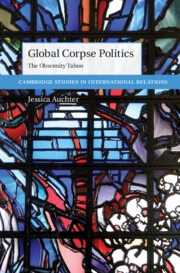Global Corpse Politics
Taboos have long been considered key examples of norms in global politics, with important strategic effects. Auchter focuses on how obscenity functions as a regulatory norm by focusing on dead body images. Obscenity matters precisely because it is applied inconsistently across multiple cases. Examining empirical cases including ISIS beheadings, the death of Muammar Qaddafi, Syrian torture victims, and the fake death images of Osama bin Laden, this book offers a rich theoretical explanation of the process by which the taboo surrounding dead body images is transgressed and upheld, through mechanisms including trigger warnings and media framings. This corpse politics sheds light on political communities and the structures in place that preserve them, including the taboos that regulate purported obscene images. Auchter questions the notion that the key debate at play in visual politics related to the dead body image is whether to display or not to display, and instead narrates various degrees of visibility, invisibility, and hyper-visibility.
- Leads the reader to rethink their own encounters with familiar images and consider them in the context of larger theoretical insights
- Theorizes the impact of obscenity in global politics via an empirical examination of dead body images
- Advances work on emotion and embodiment in international politics, speaks to emerging literatures on materiality, affect, embodiment, and visuality in international relations
Reviews & endorsements
'In this stunning, brilliantly written, empirically rich and courageously incisive book, Jessica Auchter examines how an 'obscenity taboo' inconsistently governs and disciplines how the dead in international politics are seen. Such inconsistency tells us something about various layers of political community in global politics. Yet this electrifying study tells us even more, about how, paradoxically, the dead re-humanize, de-humanize, and functionally shape global politics for the living.' Brent J. Steele, Professor and Francis D. Wormuth Presidential Chair of Political Science, The University of Utah
'In this stunning book, Auchter undertakes a meticulous exploration of the politics of obscenity, particularly as obscenity relates to dead bodies. Global Corpse Politics brings troubling and challenging questions into discussions on visual politics and the politics of representation. Throughout the book, Auchter explains with astonishing clarity, audacity, humility, and often poignancy how decisions with regards to 'dead body images' are always political choices. These decisions partake of the global politics of the obscene, and they repeatedly reframe the relationship between death–and its visual rendition–and what it means to be human. Global Corpse Politics is a masterful work of critical scholarship that must be read by many, irrespective of their disciplinary backgrounds or intellectual interests.' François Debrix, Director of the ASPECT program and Professor of Political Science, Virginia Tech
'What can the dead tell us about global politics? In this thoughtful and considerate book, Jessica Auchter refuses to see dead bodies as the grisly remnants of global politics. Instead, she explains how corpses work to constitute global politics, focusing particular attention on how dead bodies have been used to both re-humanise and de-humanise the people that populate international landscape. This book is essential reading for anyone interested in images of death that circulate in the media because it provides the theoretical tools we need to understand how death is seen, whose deaths are seen, and what these death reveal about the living world we inhabit.' Thomas Gregory, Senior Lecturer, University of Auckland
Product details
October 2021Hardback
9781316511657
270 pages
235 × 158 × 18 mm
0.46kg
Available
Table of Contents
- 1. Visualizing corpse politics
- 2. Horrifically graphic: the obscene corpse
- 3. The visual politics of ISIS beheadings
- 4. Dead terrorists and dead dictators
- 5. Proof of death: evidence and atrocity
- 6. Displaying the dead body: Some conclusions.










